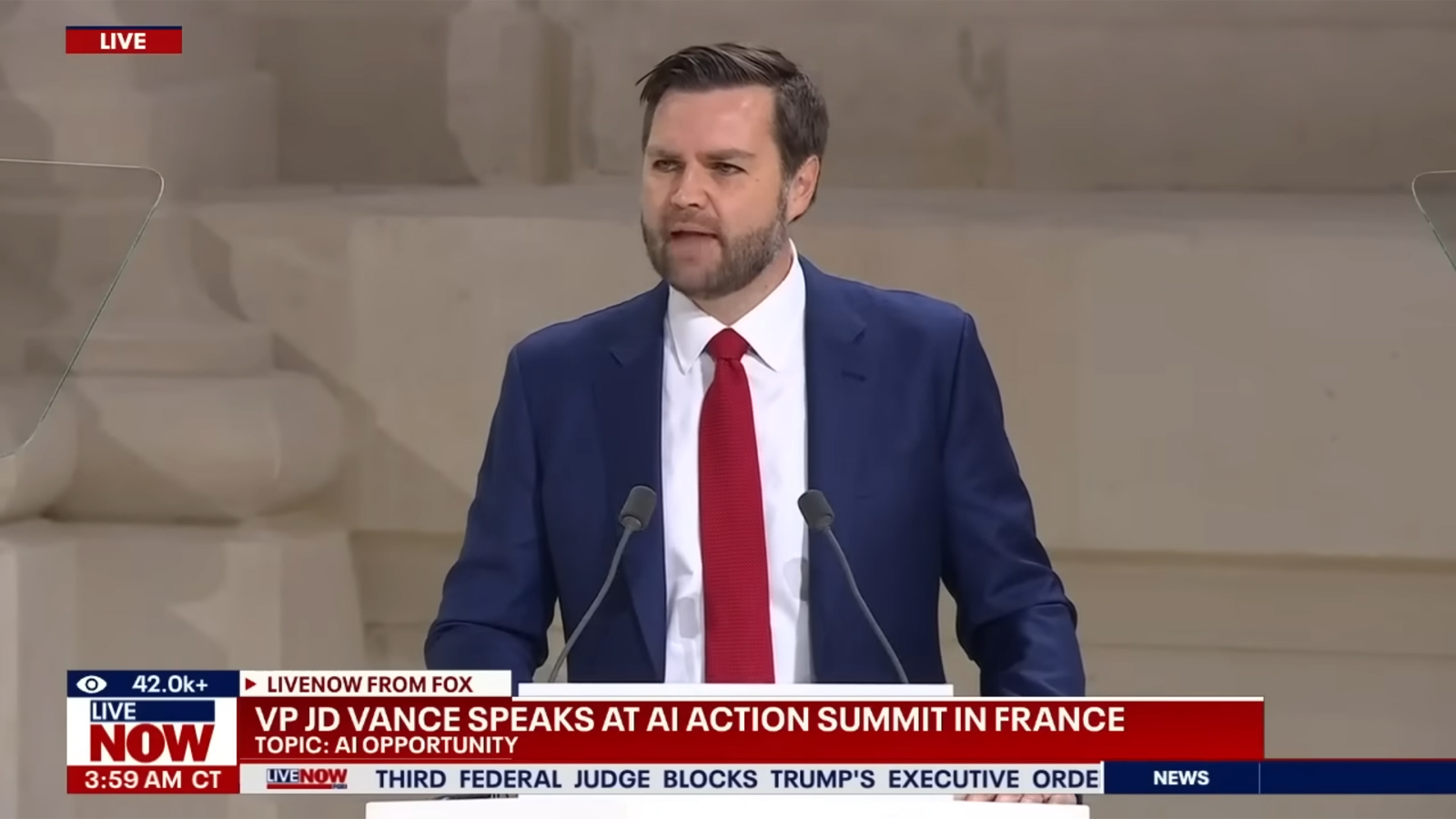Trump administration declares 'most powerful' AI chips will be built in America
"The most powerful AI systems are built in the US with American-designed and manufactured chips.”

US Vice President JD Vance took to the podium as he gave a keynote on the final day of the Paris AI Action Summit, where he gave several key insights on the Trump administration’s strategy on the technology. During his speech, Vance focused on the opportunities that AI brings, and that the White House will continue supporting the technology through its policies.
“The United States of America is the leader in AI and our administration plans to keep it that way. The US possesses all components across the full AI stack, including advanced semiconductor design, frontier algorithms, and, of course, transformational applications,” said the Vice President. “Now the computing power this stack requires is integral to advancing AI technology, and to safeguard America’s advantage, the Trump administration will ensure the most powerful AI systems are built in the US with American-designed and manufactured chips.”
This announcement is good news for the semiconductor industry, especially as Trump has previously voiced opposition to the CHIPS and Science Act during his campaign. This is in addition to the act currently making its way through the U.S. Congress that would give tax credits to chip designers and manufacturers, helping boost semiconductor innovation within the country. He added that Washington is already working on an AI strategy that will remove overly precautionary regulations while remaining beneficial to the American public.
Vance invited other countries to partner with the U.S. and also welcomed them to replicate this policy. But he also criticized the European Union’s regulations—specifically, the Digital Services Act and GDPR — which he called “onerous international rules.” The VP said these impose excessive legal costs on smaller firms and are stifling free speech by preventing an adult from “accessing an opinion that the government thinks is misinformation.” He also emphasized AI’s need for electricity, saying that it needs high-quality semiconductors and reliable power sources, but that many countries are choosing to de-industrialize while removing stable power sources from their grids.
Lastly, he also warned against partnering with hostile authoritarian regimes, saying that even though they deliver cheap technologies right now, long-term partnerships with them will not pay off. While he didn’t directly mention China (whose representative was seated close by), Vance called out cheap 5G and CCTV equipment, Chinese exports that are widely used in the U.S. and its allies until they were banned and removed starting in 2019.
“Some of us in this room have learned from experience, partnering with them means chaining your nation to an authoritarian master that seeks to infiltrate, dig in, and seize your information infrastructure,” VP JD Vance said. “Should a deal seem too good to be true, just remember the old adage that we learned in Silicon Valley, ‘If you aren’t paying for the product, you are the product.’”
Get Tom's Hardware's best news and in-depth reviews, straight to your inbox.

Jowi Morales is a tech enthusiast with years of experience working in the industry. He’s been writing with several tech publications since 2021, where he’s been interested in tech hardware and consumer electronics.
-
jp7189 Despite the "drill baby drill" rhetoric, I'm hoping nuclear takes center stage for power expansion in the US. Newer designs are so much better, and we just need regulators to push approvals though. It would be great if we see an overhaul of that process.Reply -
P.Amini Reply
Nuclear is green when it works as intended but a DISASTER when it fails (earthquake, etc.). Everything is safe and sound? Take a look at what happened to LA recently.jp7189 said:Despite the "drill baby drill" rhetoric, I'm hoping nuclear takes center stage for power expansion in the US. Newer designs are so much better, and we just need regulators to push approvals though. It would be great if we see an overhaul of that process. -
evdjj3j Reply
Don't build your power plant on a fault line.P.Amini said:Nuclear is green when it works as intended but a DISASTER when it fails (earthquake, etc.). Everything is safe and sound? Take a look at what happened to LA recently. -
bit_user Reply
AFAIK, there are isotopes which don't have the potential to meltdown (Thorium?), the way Uranium does. I'm sure @The Historical Fidelity would know more.P.Amini said:Nuclear is green when it works as intended but a DISASTER when it fails (earthquake, etc.). Everything is safe and sound? Take a look at what happened to LA recently.
I wonder if there's any way you could scale up the "nuclear battery" approach, since relying on a steam-driven turbine might not be feasible in some arid regions.
https://www.tomshardware.com/pc-components/power-supplies/chinese-developed-nuclear-battery-has-a-50-year-lifespan -
bit_user Reply
Or put the backup generators for cooling them below crest height of a tsunami, right?evdjj3j said:Don't build your power plant on a fault line. -
mitch074 Bashing GDPR because it aims at protection personal data ? Sure, companies would love going back to a time where they could go whatever they wanted with your personal data - scams, spam etc. Now they'll use that to train an AI that will also consider opinions to be better than fact, the leader's morals as its 'moral' compass, and driving its weapons.Reply
Skynet, at least, was logical. -
jp7189 I just looked up the numbers. To power a single gigawatt AI datacenter in Teaxs (region is rated at 20% capacity factor) would require 31,250 acres of solar panels. Plus you'd need an immense amount of battery storage to go with it. A complete nuclear facility needs 1-2,000 acres, and no battery storage to produce significantly more than 1 GW (up to 8GW)Reply
Stargate is talking about 10-20 datacenters.. though they didn't talk about power usage.
The vast majority of power generation in Texas is fossil fuels. As it stands now most of the new datacenters will run on natural gas and coal power. -
SonoraTechnical Feels like we are going to see something like Mortal Engines played out eventually. LOL!! Ah, what a bright AI driven future lies ahead....Reply
